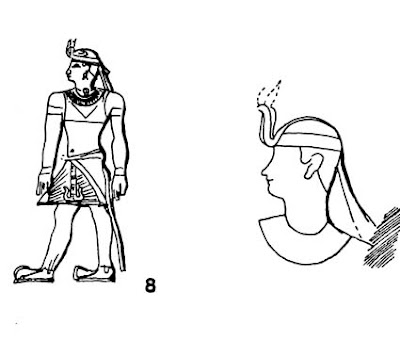
For this National Geographic illustration I needed to show a triumphant Kushite king accepting the homage of vanquished princes in Egypt in 724 BCE.
 I first met with the project archaeologist Dr. Timothy Kendall in the basement of the Museum of Fine Arts in Boston. He showed me primary-source drawings of the snake headdress, sandals, wing corselet, and transparent garment worn by Kushite royalty.
I first met with the project archaeologist Dr. Timothy Kendall in the basement of the Museum of Fine Arts in Boston. He showed me primary-source drawings of the snake headdress, sandals, wing corselet, and transparent garment worn by Kushite royalty. I wrapped myself in a sheer curtain to simulate the costume. I set up the tone paper on an easel and acted out the pose, looking at the reflection in a full-length mirror mounted on a door.
I wrapped myself in a sheer curtain to simulate the costume. I set up the tone paper on an easel and acted out the pose, looking at the reflection in a full-length mirror mounted on a door. Even though I’m not exactly the right type for the character I was portraying, I was only looking for the basic structure of the pose. I could get the Nubian features from other sources.
Even though I’m not exactly the right type for the character I was portraying, I was only looking for the basic structure of the pose. I could get the Nubian features from other sources. I recommend the method for three reasons. It’s often faster than shooting photo reference. It gets you immediately away from the photographic look. And it forces you to begin interpreting the pose, making artistic decisions that give your result more coherence and impact.
Mirror studies have always been a favorite method for animators acting out facial expressions and gestures. For faces, you can use a medium sized mirror hung in front of your work table.
------------
For a previous GJ post on installing a full-length mirror, link.
Here's a selected list of articles I've illustrated for National Geographic:
March 2006 Battle of Hampton Roads
Dec. 1997 Patagonian Dinosaurs
Nov. 1990 Kingdom of Kush
Feb. 1989 Attic Scene
Oct. 1988 Moche, Peru
May 1988 Wool
June 1988 Etruscans
July 1987 Soybeans
June 1987 Eskimos
Aug. 1986 Ulysses
Sept. 1985 Jason
Sept. 1985 Humboldt







8 comments:
Ha...I have the issue of Step-by-step that this was in. Thankfully with Leif Peng's Today's Inspiration blog I don't have to pine away the days of the long deceased magazine.
=s=
Did you also pose your other hand that's raised and drew it from memory? Just curious. Thanks.
Great Post.
The mirror IS a good alternative to photography -- while it is limiting somewhat in terms of poses, the mirror focuses your concentration and observation in an active way -- somehow working from photos seems more passive.
But I really find the process by which you gathered your reference the most interesting -- how you turned the archaeological into the artistic.
Maybe in a future post you could dissect one of your paintings and describe the "journey" you went on to gather all the reference -- especially if it involves museum visits (maybe thats the point of the Step-by-step article Shane mentioned).
Thanks for the Nat Geo illos list -- I'll have to go through my old mags and see if I have any.
Jim,
What I wanna know is how did you manage drawing yourself in the prostrated pose in front of the King?
Very good post. Your idea saves me the histrionics of dashing in front of my camera after I have pressed the shutter timer.
Daroo, yes, Shane is referring to a 10-page article with 34 illustrations that analyzes the making of this one painting in great detail. It's in the November/December 1990 issue of Step-by-Step Graphics Magazine.
I am also grateful to Leif Peng for all the great material he has shared on Today's Inspiration: http://todaysinspiration.blogspot.com/
Frank--you have put your finger on the shortcoming of mirror studies--you're locked into a fixed eye level (unless you tilt the mirror) and certain head positions (unless you use multiple mirrors).
Pat, yes, the drawing hand has to be drawn from memory, but that's been true of a lot of self-portraits.
Jim,
I am learning alot from you bro! Keep up the great posts....
blessings
Simply inspirational!
There's real magic in traditionally painted illustrations. Great advice as always, maybe someday you should gather all of this knowledge in a "how to" book. I think it would sell like hot cakes.
Post a Comment